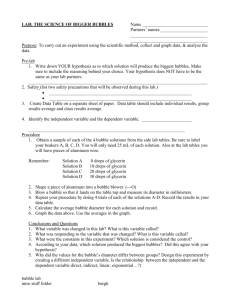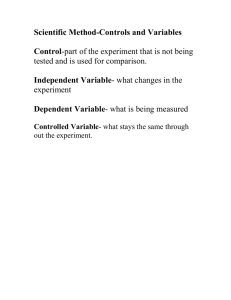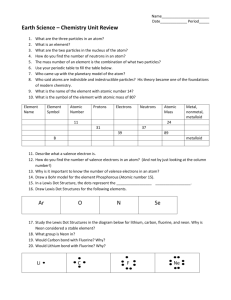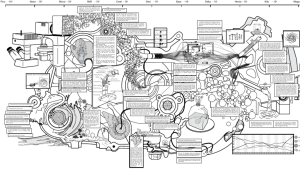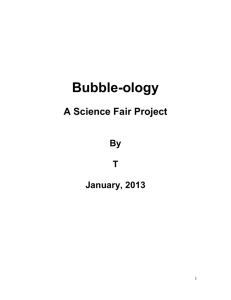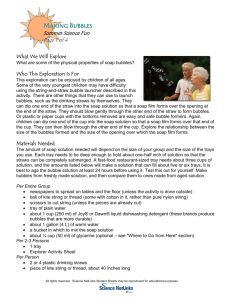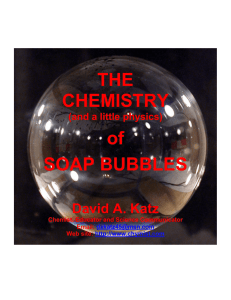Students explore soap bubbles, what makes good bubble
advertisement
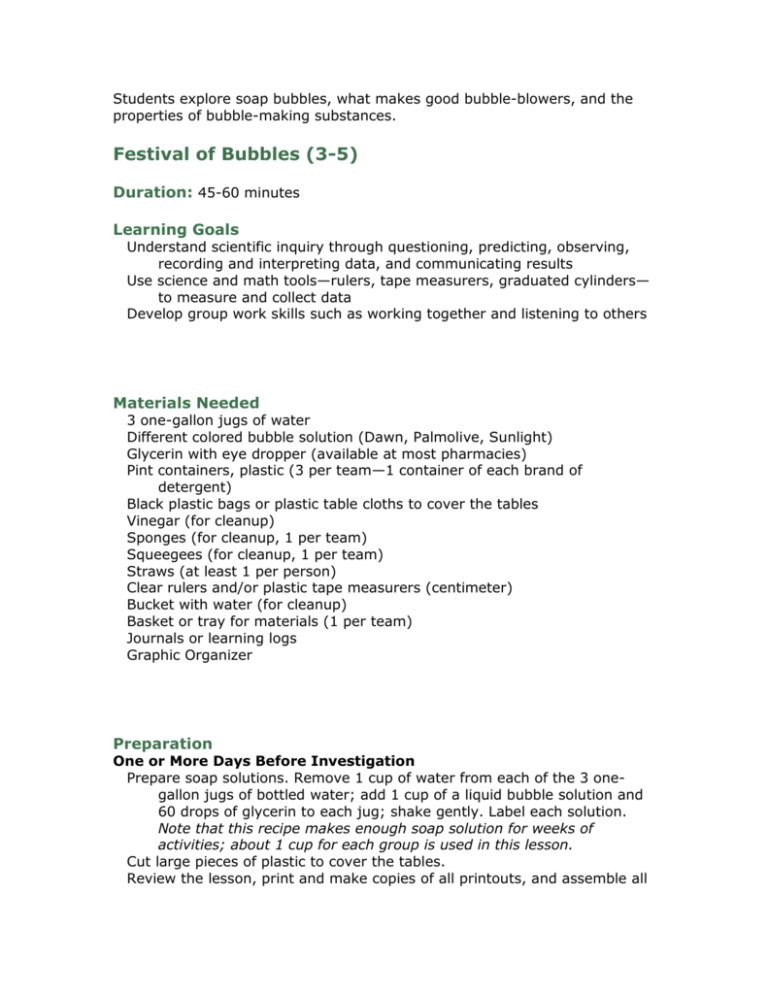
Students explore soap bubbles, what makes good bubble-blowers, and the properties of bubble-making substances. Festival of Bubbles (3-5) Duration: 45-60 minutes Learning Goals Understand scientific inquiry through questioning, predicting, observing, recording and interpreting data, and communicating results Use science and math tools—rulers, tape measurers, graduated cylinders— to measure and collect data Develop group work skills such as working together and listening to others Materials Needed 3 one-gallon jugs of water Different colored bubble solution (Dawn, Palmolive, Sunlight) Glycerin with eye dropper (available at most pharmacies) Pint containers, plastic (3 per team—1 container of each brand of detergent) Black plastic bags or plastic table cloths to cover the tables Vinegar (for cleanup) Sponges (for cleanup, 1 per team) Squeegees (for cleanup, 1 per team) Straws (at least 1 per person) Clear rulers and/or plastic tape measurers (centimeter) Bucket with water (for cleanup) Basket or tray for materials (1 per team) Journals or learning logs Graphic Organizer Preparation One or More Days Before Investigation Prepare soap solutions. Remove 1 cup of water from each of the 3 onegallon jugs of bottled water; add 1 cup of a liquid bubble solution and 60 drops of glycerin to each jug; shake gently. Label each solution. Note that this recipe makes enough soap solution for weeks of activities; about 1 cup for each group is used in this lesson. Cut large pieces of plastic to cover the tables. Review the lesson, print and make copies of all printouts, and assemble all materials. Day of Investigation Pour solutions into labeled pint containers. Organize materials in plastic tubs, trays, or baskets—one for each table per team—1 cup of solution, 4 to 5 straws (1 per person), plastic cover, rulers, tape measure, pencils or pens, learning logs (if used, 1 per person), sponges. Have vinegar, squeegees, and buckets on hand for cleanup. First squeegee the area to remove as much soap solution as possible, and then sprinkle vinegar over the area and squeegee again or wipe with a sponge. Safety Considerations open Students should wear safety goggles to protect their eyes. Students should wear smocks, oversized T-shirts, or aprons to protect their clothing. If solution gets in a student's eyes, instructors should wash his or her eyes with clear water. Instructors should have a bottle of vinegar and a mop or towel handy to clean up any spills on the floor. Newspapers can also be used for cleanup. After the investigations, students should wash their hands to remove any soap solution. What to Do Engage students by asking where they have seen or blown bubbles, and if they have ever used anything unusual to create a bubble. Record students' answers on the KWL Chart (PDF, 56K). Divide students into small groups of four, and hand out Learning Logs (PDF) and Data Sheets (PDF) for each group. Designate one student in each group to gather and return materials, one student as the chief investigator to direct the investigation, one student to record the data, and one student to be the safety inspector to make sure students are wearing goggles and keeping the area clear. Explore bubbles in small groups. Ask students to create large bubbles by spreading a thin layer of bubble solution about the size of a large pizza over a flat surface. Next, students blow a bubble by wetting a straw and gently blowing just above the surface of the wet area. After the bubble pops, students measure the diameter of the bubble "footprint" to the nearest 0.1 cm using a clear ruler or a tape measure. Students should record their answers in their learning logs. After all students have an opportunity to blow three bubbles each with one solution, they can clean up their area and rotate to another table with a different solution. They will need about 15 minutes per solution. Explain the results. Ask students to complete their data sheets and find their own and their team's average bubble size for each solution. Each team will report their results. Record each team's results on the Class Data Sheet (PDF). To see one example of a completed data chart, see the Sample Class Data Chart (PDF). Note that the results in this chart will be different from students' results. Have students compare their data, their team's data, and the class data as they complete their learning logs. Discuss the results and have students write a conclusion. Which liquid detergent makes the largest bubble? Extend students' learning if you have extra time. Read the poem "Blowing Soap Bubbles" by Gerard Manley Hopkins and ask students to write and illustrate their own bubble poem. You may want to research and study how liquid detergent is made, test several more liquid detergents, or vary the amount of glycerin used in one brand of detergent to see if that variable makes a difference in the size of the bubbles. Create a bar graph to record the average class data. Evaluate (Outcomes to Look For) Student participation and engagement Students collaborate and work together Answers that reflect an understanding of how to observe and measure bubbles, and how to find the average bubble size Answers that reflect an understanding of how to collect, record, and interpret data

